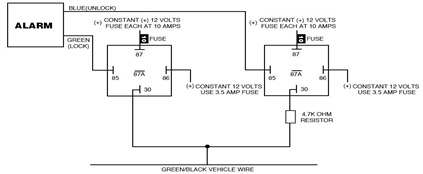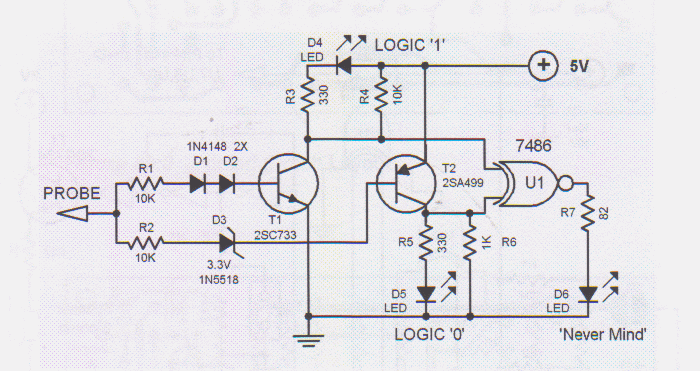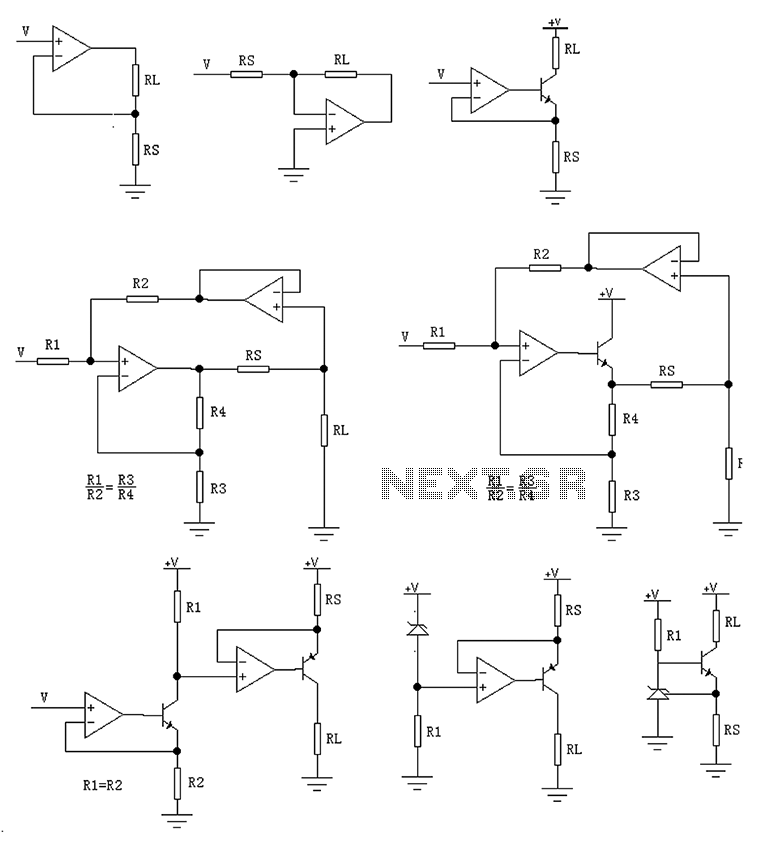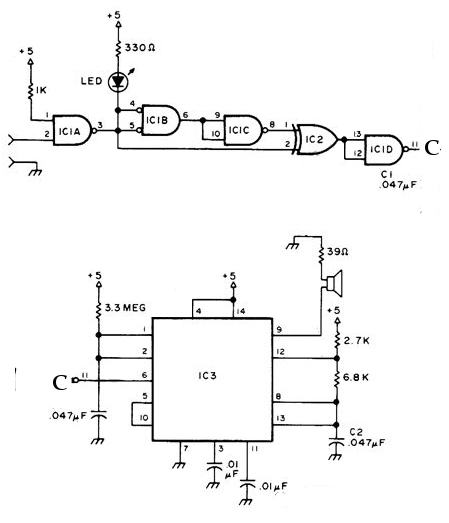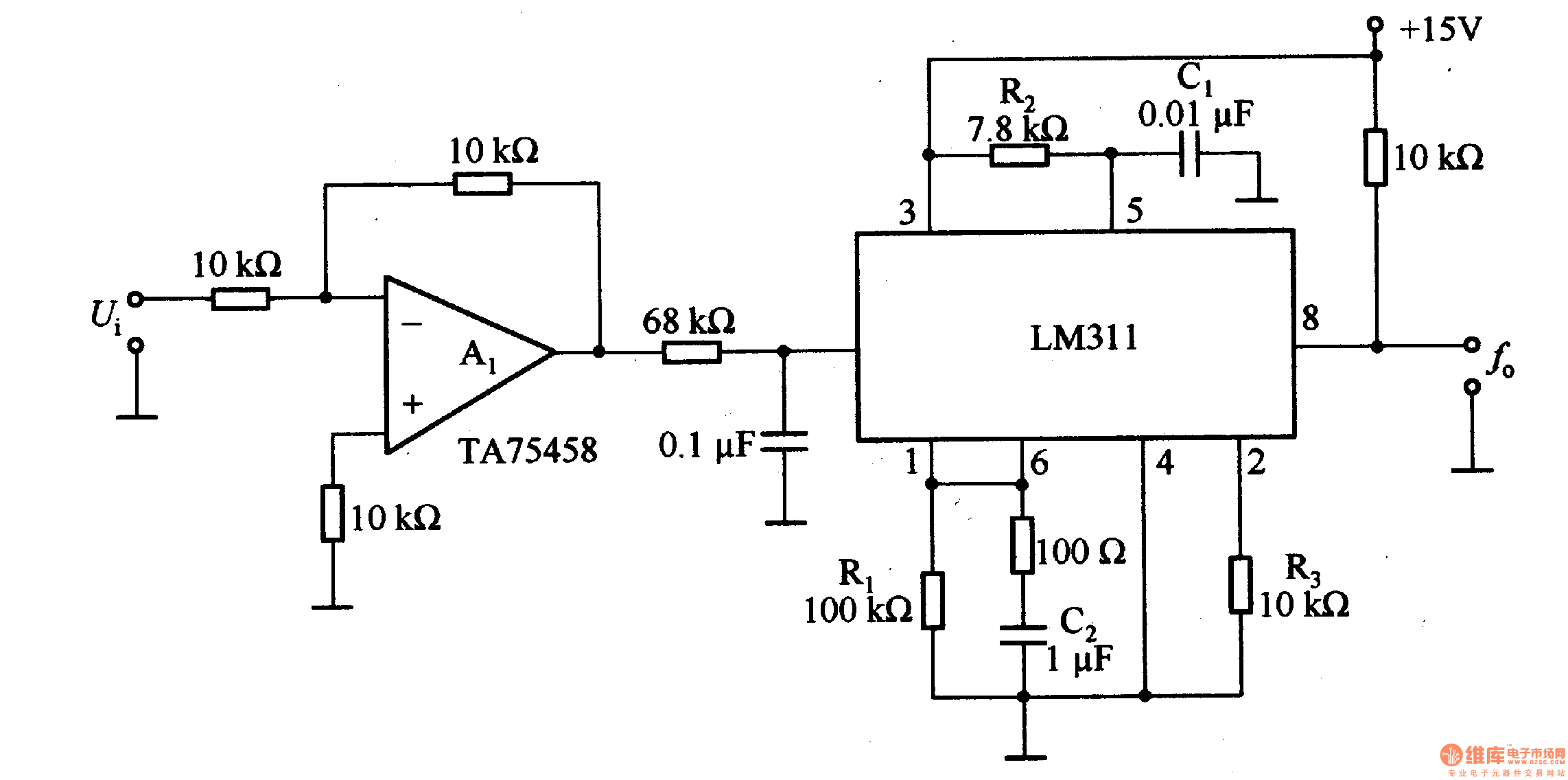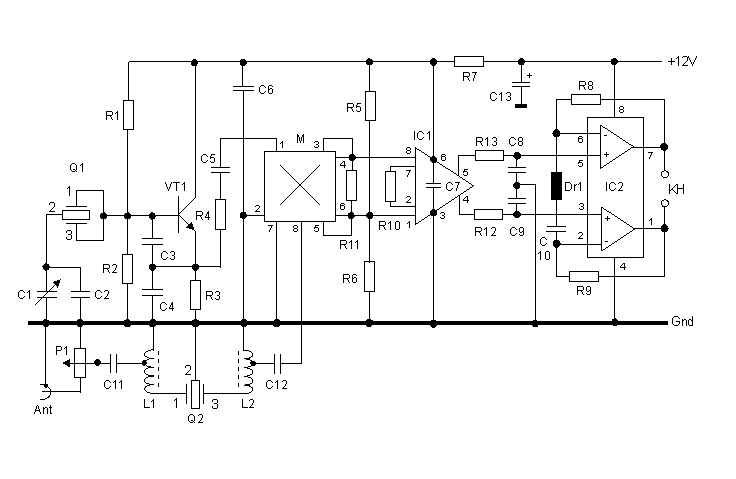
EMF Probe Version 2
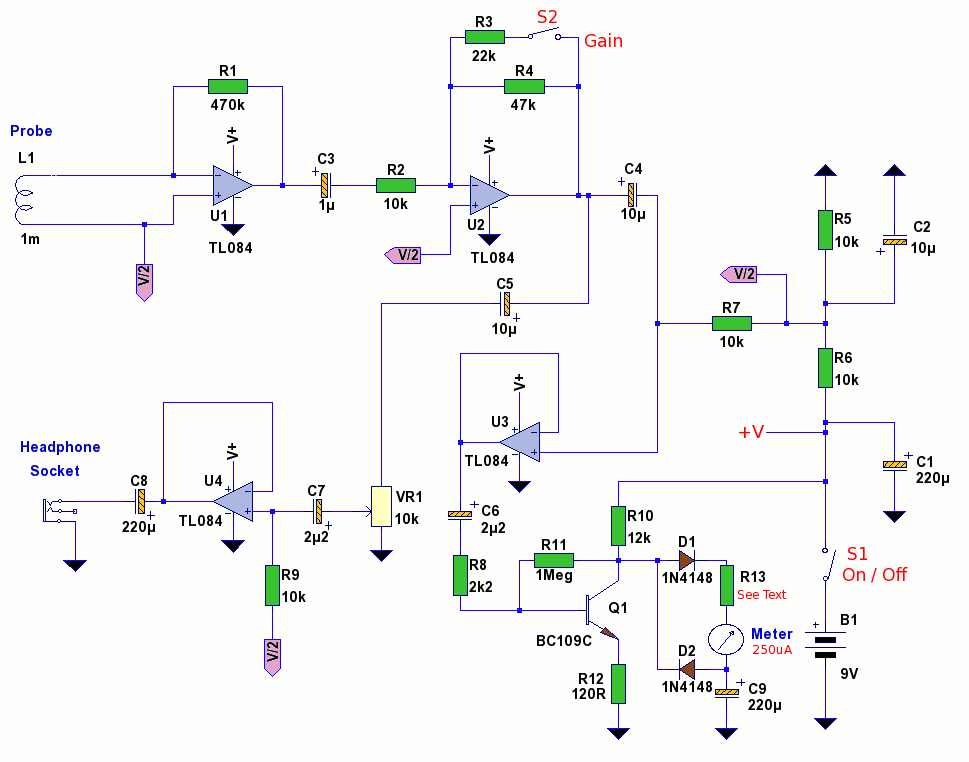
An electromagnetic field probe designed to detect changing electric and magnetic fields. The probe features switchable gain, a frequency response of up to 400 kHz, and independent audio and meter monitoring. This EMF probe utilizes an inductor to locate stray electromagnetic (EM) fields and responds to both changing magnetic and electric fields, as each induces a voltage in the inductor. The circuit is built around a quad low-noise FET input operational amplifier, type TL084, with individual op-amps labeled U1 to U4. The power supply consists of a single 9 Volt battery, divided by resistors R5 and R6. Capacitors C1 and C2 smooth variations in battery voltage, while S1 serves as the on/off switch. The input stage U1 is directly coupled to the probe, which consists of a radial wound 1 mH inductor, type Toko 8RB. This component is available from Jabdog Electronics in the UK (part number 187LY-102J). If unavailable, inductors of 1.2, 1.5, or 1.8 mH can be used. The reactance of the inductor varies with input frequency, and the stage gain is very high. Since there is no offset null control in the TL084, the output is capacitively coupled via C3 to the next TL084 amplifier, U2. This stage features switchable gain of approximately 1.5x and 4.7x, controlled by S2. The output gain of both U1 and U2 stages (with switch S2 open) is about 70 dB at 1 kHz and approximately 30 dB at 400 kHz, although the signal meter may not be accurate at such high frequencies. The output from U2 is split by capacitors C4 and C5, driving an independent headphone amplifier built around U4. VR1 acts as a volume control, with the output available as either a mono or stereo miniature jack plug. The output stage of the TL084 can sufficiently drive 32-ohm headphones, such as Sennheiser or iPod Shuffle. U3 forms part of the signal meter circuit, wired as a voltage follower. The EMF signal has any DC component removed by C6 before passing to the meter driver circuit, which is based on Q1 and associated components. Q1 is a BC109C transistor, although a 2N2222 transistor may be used as an alternative. Q1 operates as a common emitter amplifier with a voltage gain of approximately 10, set by the ratio of R10 to R12. R8 increases the input impedance and helps to linearize the gain. The voltage at Q1's collector is high enough to bias diodes D1 and D2, which function as a full-wave rectifier circuit across the meter. Capacitor C9 has a large value to enable the meter to respond to low mains frequencies of 50 Hz. The signal meter used has a full-scale deflection (FSD) of 250 µA. If a similar-rated meter is used, R13 is not needed. For greater sensitivity, a 100 µA or 50 µA meter may be used, in which case R13 can be introduced, with its value approximately four times the meter's coil resistance, or omitted for a very sensitive meter circuit. The Maplin meter, available from Maplin Electronics (part number LB80B), has a FSD of 250 µA and an internal resistance of 675 ohms. Any meter with similar sensitivity can also be used. Meters rated at 100 or 50 µA FSD can be employed, provided a suitable series resistor is used. Due to the circuit's response to RF frequencies up to several hundred kHz, a smoothing capacitor across the meter should not be used, as this would effectively short-circuit the meter, reducing the average current to zero. The probe is constructed from an old pen tube, with the end cap removed. A 50 cm length of audio screened cable is threaded through the pen tube and soldered to the radial inductor. The capacitance of the 50 cm audio cable is approximately 2 pF; longer cables should be avoided as they will deteriorate high-frequency performance. The cable may be connected with a 3.5 mm mono plug and socket if desired. The inductor fits snugly against the pen tube's body, and insulating tape or glue may be used to secure the pen body to the inductor. When modeling this circuit in LTspice or any other simulator, it is essential to account for the input capacitance of the probe cable and the impedance of the inductor. The cable capacitance measured by a capacitance meter was found to be 1.9 pF, so 2 pF is added in parallel with L2, which is the probe inductor. The Toko 8RB inductor has a series resistance of 7 ohms; at 100 kHz, the impedance is 628.3 ohms. The series resistance of L2 must be included in LTspice, where the inductor L2 can be right-clicked to enter a value for series resistance. A transient response at 10 kHz can be simulated, with the model featuring three nodes labeled Vgain, Vheadphone, and Vmeter for clarity. The input has been simulated using a signal generator feeding another coil, with a coupling coefficient of 0.9 and an input voltage of 10 mV peak-to-peak. The simulation circuit for LTspice can be downloaded and loaded into the software. The file includes models for the potentiometer and TL072, which is compatible with the quad TL084 model. An audio or RF signal generator can be used to apply an input signal to the windings of a small transformer or another inductor, creating an electromagnetic field easily detected by the probe. Without a signal generator, placing the probe near a power supply, mains wiring, or other electrical devices will yield a meter deflection and sound in the headphones if the frequency is below 15 kHz. Frequencies above 15 kHz will produce inaudible sounds, but harmonics may still be present, with the meter circuit responsive up to 400 kHz. A simplified test circuit can be built on a breadboard, replacing U1 and U2 with a single stage utilizing a 2.2 MΩ resistor for gain. The final stage consists of the voltage follower and full-wave meter circuit. Meter leads should be disconnected for clarity, with connection points marked. The mains wiring without load results in a deflection of 0.5 (25 µA) on the 250 µA meter. The signal from wiring on a 60 Watt desk lamp yields a stronger reading of about 2, while the electromagnetic field from a transformer provides full-scale deflection from several inches away. The circuit can be constructed on veroboard for portability. Moving the probe near a light switch or electric socket will produce a loud hum in the headphones, along with meter deflection.An electromagnetic field probe designed to detect changing electric and magnetic fields. The probe has switchable gain, a frequency response up to 400kHz and independent audio and meter monitoring. This EMF probe uses an inductor to locate stray electromagnetic (EM) fields. It will respond to both changing magnetic and electric fields as each will induce a voltage in the inductor. The circuit is built around a quad low noise FET input op-amp, type TL084. The individual op-amps inside the TL084 are labelled as U1 to U4. Power supply is a single 9 Volt battery, the supply being divided by R5 and R6. C1 and C2 help smooth variations in battery voltage, S1 is the on off switch. The input stage U1, is direct coupled to the probe, a radial wound 1mH inductor, type Toko 8RB as shown in the probe construction. This part appears only available from Jabdog Electronics in the UK, part number 187LY-102J. If not available then the 1. 2, 1. 5 or 1. 8mH inductor will work equally well. The reactance of the inductor changes with input frequency and stage gain is very high. As there is no offset null control in the TL084 then the output is capacitively coupled via C3 to the next Tl084 amplifier U2.
This stage has switchable gain of approximately 1. 5x and 4. 7x controlled by S2. The output gain of both U1 and U2 stages ( with switch S2 open ) is about 70dB at 1KHz. Gain is still about 30dB at 400KHz, although the signal meter will not be too accurate at such high frequency. The bode plot simulated in LTspice is shown below: The output from U2 is split by C4 and C5 and drives an independent headphone amplifier built around U4.
VR1 acts as a volume control the output being either a mono or stereo miniature jack plug as shown. The output stage of the TL084 is sufficiently low to drive 32 ohm headphones like Sennheiser or Ipod Shuffle, etc. U3 forms part of the signal meter circuit. U3 is wired as a voltage follower, the EMF signal has any DC component removed by C6 and then passed to the meter driver circuit based on Q1 and associated components.
Q1 is a BC109C transistor, although a 2N2222 transistor could be used as an alternative part. Q1 is a common emitter amplifier with a voltage gain of about 10, set by the ratio R10 / R12. R8 acts to increase input impedance to the stage and also helps to linearise the gain. The voltage at Q1 collector is high enough to bias diodes D1 and D1 which act as a full wave rectifier circuit across the meter. C9 has a large value, this is so the meter can respond to low mains frequencies of 50Hz. The signal meter used has a full scale deflection FSD of 250uA. If a similar rated meter is used R13 is not needed. If greater sensitivity is required then a 100uA or 50uA meter may be used. In this case the meter circuit may become too sensitive so R13 can be introduced, its value should be about 4x the meters coil resistance, or can be left out altogether for a very sensitive meter circuit.
The Maplin meter is shown below. This signal meter is available from Maplin Electronics part number LB80B and has a FSD of 250uA and an internal resistance of 675 ohms. However any meter will work having a similar sensitivity. Meters of 100 or 50uA FSD can also be used providing a suitable series resistor is used. Because the circuit is responding to RF frequencies up to several hundred kHz a smoothing capacitor across the meter should not be used as this would appear as an effective short circuit reducing the average current through the meter to zero.
The probe is made from an old pen tube, the end cap being removed. A 50cm length of audio screened cable is threaded through the pen tube and soldered to the radial inductor. The capacitance of 50cm audio cable is about 2pF, longer cable should not be used as high frequency performance will deteriorate.
The cable may be used with a 3. 5mm mono plug and socket if desired. My completed probe is shown below. The diameter of the inductor fitted neatly against the body of the pen tube. A layer of insulating tape or glue may be used to secure the pen body to the inductor. To model this circuit in LTspice or any other simulator you have to take into account the input capacitance of the probe cable, and the impedance of the inductor itself. The cable capacitance was measured by a capacitance meter and came out at 1. 9pF, so 2pF was added in parallel with L2 which is the probe inductor. The simulation schematic is shown below: The Toko 8RB inductor has a series resistance of 7 ohms, at 100kHz the impedance is 628.
3 ohms. The series resistance of L2 needs to be included, in LTspice the inductor L2 can be right clicked and a value for series resistance entered, or as shown above can be entered in the value of Rs. A transient response at 10kHz is shown below: The simulation model has 3 nodes labeled Vgain, Vheadphone and Vmeter for clarity.
These waveforms are shown above. The input has been simulated by a signal generator feeding another coil. The coupling coefficient of 0. 9 is used and input voltage of 10mV pk-pk used. The simulation circuit for LTspice can be downloaded here. Unzip the file and then load the circuit. The file now contains models for the potentiometer and TL072, which is the same model as the quad TL084 model. If you have access to an audio or RF signal generator you can apply an input signal to the windings of a small transformer or another inductor.
This will set up an electromagnetic field which will be easily detected by the probe. Without a signal generator, just place the probe near a power supply, mains wiring or other electrical device. There will be a deflection on the meter and sound in the headphones if the frequency is below 15KHz. Over 15kHz, sounds will be inaudible, but there may be harmonics, but the meter circuit will still respond up to 400kHz.
I made a simplified test circuit on breadboard. U1 and U2, were replaced by a single stage, with 2. 2Meg resistor for gain. The final stage was the voltage follower and FW meter circuit as shown below. Meter leads disconnected for clarity Red and Black circle mark connection points. The mains wiring with no load gave a defelection of 0. 5 (25uA) on the 250uA meter. The signal from wiring on a 60 Watt desklamp was stronger with a reading of about 2 and the electro magnetic field from a transformer gave full scale deflection from several inches away. Switch on, set VR1 to minimum and plug in headphones (optional). The circuit can be built on veroboard and is designed to be portable. Try moving the probe near a light switch or electric socket and a loud hum will be heard in the headphones and meter will deflect.
We aim to transmit more information by carrying articles. Please send us an E-mail to wanghuali@hqew. net within 15 days if we are involved in the problems of article content, copyright or other problems. We will delete it soon. 🔗 External reference
This stage has switchable gain of approximately 1. 5x and 4. 7x controlled by S2. The output gain of both U1 and U2 stages ( with switch S2 open ) is about 70dB at 1KHz. Gain is still about 30dB at 400KHz, although the signal meter will not be too accurate at such high frequency. The bode plot simulated in LTspice is shown below: The output from U2 is split by C4 and C5 and drives an independent headphone amplifier built around U4.
VR1 acts as a volume control the output being either a mono or stereo miniature jack plug as shown. The output stage of the TL084 is sufficiently low to drive 32 ohm headphones like Sennheiser or Ipod Shuffle, etc. U3 forms part of the signal meter circuit. U3 is wired as a voltage follower, the EMF signal has any DC component removed by C6 and then passed to the meter driver circuit based on Q1 and associated components.
Q1 is a BC109C transistor, although a 2N2222 transistor could be used as an alternative part. Q1 is a common emitter amplifier with a voltage gain of about 10, set by the ratio R10 / R12. R8 acts to increase input impedance to the stage and also helps to linearise the gain. The voltage at Q1 collector is high enough to bias diodes D1 and D1 which act as a full wave rectifier circuit across the meter. C9 has a large value, this is so the meter can respond to low mains frequencies of 50Hz. The signal meter used has a full scale deflection FSD of 250uA. If a similar rated meter is used R13 is not needed. If greater sensitivity is required then a 100uA or 50uA meter may be used. In this case the meter circuit may become too sensitive so R13 can be introduced, its value should be about 4x the meters coil resistance, or can be left out altogether for a very sensitive meter circuit.
The Maplin meter is shown below. This signal meter is available from Maplin Electronics part number LB80B and has a FSD of 250uA and an internal resistance of 675 ohms. However any meter will work having a similar sensitivity. Meters of 100 or 50uA FSD can also be used providing a suitable series resistor is used. Because the circuit is responding to RF frequencies up to several hundred kHz a smoothing capacitor across the meter should not be used as this would appear as an effective short circuit reducing the average current through the meter to zero.
The probe is made from an old pen tube, the end cap being removed. A 50cm length of audio screened cable is threaded through the pen tube and soldered to the radial inductor. The capacitance of 50cm audio cable is about 2pF, longer cable should not be used as high frequency performance will deteriorate.
The cable may be used with a 3. 5mm mono plug and socket if desired. My completed probe is shown below. The diameter of the inductor fitted neatly against the body of the pen tube. A layer of insulating tape or glue may be used to secure the pen body to the inductor. To model this circuit in LTspice or any other simulator you have to take into account the input capacitance of the probe cable, and the impedance of the inductor itself. The cable capacitance was measured by a capacitance meter and came out at 1. 9pF, so 2pF was added in parallel with L2 which is the probe inductor. The simulation schematic is shown below: The Toko 8RB inductor has a series resistance of 7 ohms, at 100kHz the impedance is 628.
3 ohms. The series resistance of L2 needs to be included, in LTspice the inductor L2 can be right clicked and a value for series resistance entered, or as shown above can be entered in the value of Rs. A transient response at 10kHz is shown below: The simulation model has 3 nodes labeled Vgain, Vheadphone and Vmeter for clarity.
These waveforms are shown above. The input has been simulated by a signal generator feeding another coil. The coupling coefficient of 0. 9 is used and input voltage of 10mV pk-pk used. The simulation circuit for LTspice can be downloaded here. Unzip the file and then load the circuit. The file now contains models for the potentiometer and TL072, which is the same model as the quad TL084 model. If you have access to an audio or RF signal generator you can apply an input signal to the windings of a small transformer or another inductor.
This will set up an electromagnetic field which will be easily detected by the probe. Without a signal generator, just place the probe near a power supply, mains wiring or other electrical device. There will be a deflection on the meter and sound in the headphones if the frequency is below 15KHz. Over 15kHz, sounds will be inaudible, but there may be harmonics, but the meter circuit will still respond up to 400kHz.
I made a simplified test circuit on breadboard. U1 and U2, were replaced by a single stage, with 2. 2Meg resistor for gain. The final stage was the voltage follower and FW meter circuit as shown below. Meter leads disconnected for clarity Red and Black circle mark connection points. The mains wiring with no load gave a defelection of 0. 5 (25uA) on the 250uA meter. The signal from wiring on a 60 Watt desklamp was stronger with a reading of about 2 and the electro magnetic field from a transformer gave full scale deflection from several inches away. Switch on, set VR1 to minimum and plug in headphones (optional). The circuit can be built on veroboard and is designed to be portable. Try moving the probe near a light switch or electric socket and a loud hum will be heard in the headphones and meter will deflect.
We aim to transmit more information by carrying articles. Please send us an E-mail to wanghuali@hqew. net within 15 days if we are involved in the problems of article content, copyright or other problems. We will delete it soon. 🔗 External reference
